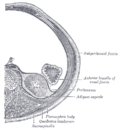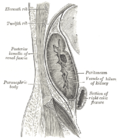Retroperitoneal space
Retroperitoneal space is an anatomical space in the abdominal cavity behind the peritoneum. It is located between the posterior parietal peritoneum and the posterior abdominal wall. The retroperitoneal space contains several important structures, including the kidneys, adrenal glands, pancreas, duodenum, ascending colon, descending colon, and major blood vessels such as the aorta and inferior vena cava.
Anatomy[edit]
The retroperitoneal space is divided into the anterior and posterior pararenal spaces and the perirenal space. The anterior pararenal space contains the pancreas, ascending and descending colon, and the second to fourth parts of the duodenum. The posterior pararenal space is a fat-filled space. The perirenal space contains the kidneys and adrenal glands.
Clinical significance[edit]
The retroperitoneal space is clinically significant because it is a potential space for the spread of disease. Conditions that can affect the retroperitoneal space include retroperitoneal fibrosis, retroperitoneal abscess, and retroperitoneal hematoma. Retroperitoneal fibrosis is a rare disease that is characterized by the presence of inflammatory and fibrous tissue in the retroperitoneal space. Retroperitoneal abscess is a collection of pus in the retroperitoneal space, which can be caused by a variety of conditions, including appendicitis, diverticulitis, and renal infection. Retroperitoneal hematoma is a collection of blood in the retroperitoneal space, which can be caused by trauma, anticoagulation therapy, or a ruptured aortic aneurysm.
See also[edit]
- Peritoneum
- Abdominal cavity
- Retroperitoneal fibrosis
- Retroperitoneal abscess
- Retroperitoneal hematoma
Retroperitoneal space[edit]
-
Retroperitoneal spaces
-
Gray's Anatomy Plate 1120
-
Gray's Anatomy Plate 1126
-
Gray's Anatomy Plate 1125
Ad. Transform your life with W8MD's Budget GLP-1 injections from $75


W8MD offers a medical weight loss program to lose weight in Philadelphia. Our physician-supervised medical weight loss provides:
- Weight loss injections in NYC (generic and brand names):
- Zepbound / Mounjaro, Wegovy / Ozempic, Saxenda
- Most insurances accepted or discounted self-pay rates. We will obtain insurance prior authorizations if needed.
- Generic GLP1 weight loss injections from $75 for the starting dose.
- Also offer prescription weight loss medications including Phentermine, Qsymia, Diethylpropion, Contrave etc.
NYC weight loss doctor appointmentsNYC weight loss doctor appointments
Start your NYC weight loss journey today at our NYC medical weight loss and Philadelphia medical weight loss clinics.
- Call 718-946-5500 to lose weight in NYC or for medical weight loss in Philadelphia 215-676-2334.
- Tags:NYC medical weight loss, Philadelphia lose weight Zepbound NYC, Budget GLP1 weight loss injections, Wegovy Philadelphia, Wegovy NYC, Philadelphia medical weight loss, Brookly weight loss and Wegovy NYC
|
WikiMD's Wellness Encyclopedia |
| Let Food Be Thy Medicine Medicine Thy Food - Hippocrates |
Medical Disclaimer: WikiMD is not a substitute for professional medical advice. The information on WikiMD is provided as an information resource only, may be incorrect, outdated or misleading, and is not to be used or relied on for any diagnostic or treatment purposes. Please consult your health care provider before making any healthcare decisions or for guidance about a specific medical condition. WikiMD expressly disclaims responsibility, and shall have no liability, for any damages, loss, injury, or liability whatsoever suffered as a result of your reliance on the information contained in this site. By visiting this site you agree to the foregoing terms and conditions, which may from time to time be changed or supplemented by WikiMD. If you do not agree to the foregoing terms and conditions, you should not enter or use this site. See full disclaimer.
Credits:Most images are courtesy of Wikimedia commons, and templates, categories Wikipedia, licensed under CC BY SA or similar.
Translate this page: - East Asian
中文,
日本,
한국어,
South Asian
हिन्दी,
தமிழ்,
తెలుగు,
Urdu,
ಕನ್ನಡ,
Southeast Asian
Indonesian,
Vietnamese,
Thai,
မြန်မာဘာသာ,
বাংলা
European
español,
Deutsch,
français,
Greek,
português do Brasil,
polski,
română,
русский,
Nederlands,
norsk,
svenska,
suomi,
Italian
Middle Eastern & African
عربى,
Turkish,
Persian,
Hebrew,
Afrikaans,
isiZulu,
Kiswahili,
Other
Bulgarian,
Hungarian,
Czech,
Swedish,
മലയാളം,
मराठी,
ਪੰਜਾਬੀ,
ગુજરાતી,
Portuguese,
Ukrainian




